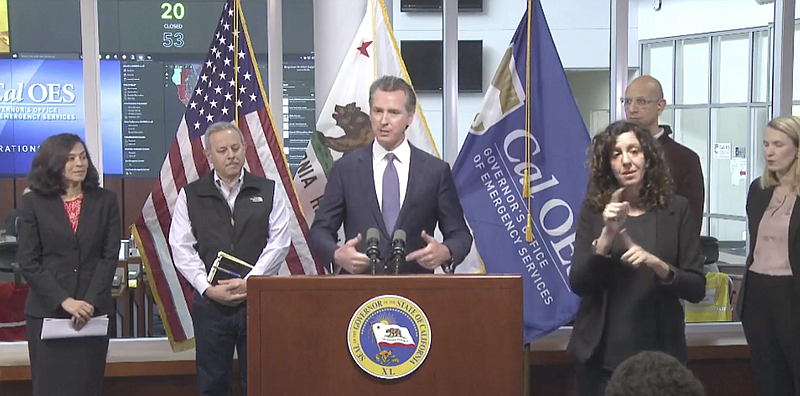 _______________________________
_______________________________
 __________________________________
__________________________________
 “In towns and cities... there is no more important institution than the local paper.”
Warren Buffett
“In towns and cities... there is no more important institution than the local paper.”
Warren Buffett

August 23, 2021
By Erwin Chemerinsky and Aaron Edlin
The most basic principles of democracy are that the candidate who gets the most votes is elected and that every voter gets an equal say in an election’s outcome.
The California system for voting in a recall election violates these principles and should be declared unconstitutional. Unless that happens, on Sept. 14, voters will be asked to cast a ballot on two questions: Should Gov. Gavin Newsom be recalled and removed from office? If so, which of the candidates on the ballot should replace him?
The first question is decided by a majority vote. If a majority favors recalling Mr. Newsom, he is removed from office. But the latter question is decided by a plurality, and whichever candidate gets the most votes, even if it is much less than a majority, becomes the next governor.
Critically, Mr. Newsom is not on the ballot for the second question. By conducting the recall election in this way, Mr. Newsom can receive far more votes than any other candidate but still be removed from office.
Many focus on how unfair this structure is to the governor, but consider instead how unfair it is to the voters who support him.
Imagine that 10 million people vote in the recall election and 5,000,001 vote to remove Mr. Newsom, while 4,999,999 vote to keep him in office. He will then be removed and the new governor will be whichever candidate gets the most votes on the second question.
In a recent poll, the talk show host Larry Elder was leading with 18 percent among the nearly 50 candidates on the ballot. With 10 million people voting, Mr. Elder would receive the votes of 1.8 million people. Mr. Newsom would have the support of almost three times as many voters, but Mr. Elder would become the governor.
That scenario is not a wild hypothetical. Based on virtually every opinion poll, Mr. Newsom seems likely to have more votes to keep him in office than any other candidate will receive to replace him. But he may well lose the first question on the recall, effectively disenfranchising his supporters on the second question.
This is not just nonsensical and undemocratic. It is unconstitutional. It violates a core constitutional principle that has been followed for over 60 years: Every voter should have an equal ability to influence the outcome of the election.
The Supreme Court articulated this principle in two 1964 cases, Wesberry v. Sanders and Reynolds v. Sims.
At the time, in many states, there were great disparities in the size of electoral districts. One district for a state legislative or a congressional seat might have 50,000 people and another 250,000. Those in the latter district obviously had less influence in choosing their representative.
In Wesberry, the court held that congressional districts of widely varying size are unconstitutional because they are akin to giving one citizen more votes than another, denying citizens equal protection as a result.
The court extended that reasoning later that year to state legislatures in Reynolds. Today the one-person one-vote principle requires roughly equal-size districts for every legislative body — the House of Representatives, state legislatures, City Councils, school boards — except for the United States Senate, where the Constitution mandates two senators per state.
After Chief Justice Earl Warren retired in 1969, he remarked that of all the cases decided during his time on the court, the one-person one-vote rulings were the most important because they protected such a fundamental aspect of the democratic process.
The California recall election, as structured, violates that fundamental principle. If Mr. Newsom is favored by a plurality of the voters, but someone else is elected, then his voters are denied equal protection. Their votes have less influence in determining the outcome of the election.
This should not be a close constitutional question.
It is true that federal courts generally are reluctant to get involved in elections. But the Supreme Court has been emphatic that it is the role of the judiciary to protect the democratic process and the principle of one-person one-vote.
This issue was not raised in 2003 before the last recall, when Gray Davis was removed from office after receiving support from 44.6 percent of the voters. But his successor, Arnold Schwarzenegger, was elected to replace him with 48.5 percent of the vote. So Mr. Schwarzenegger was properly elected.
This time, we hope that a state or federal lawsuit will be brought challenging the recall election.
The court could declare the recall election procedure unconstitutional and leave it to California to devise a constitutional alternative. Or it could simply add Mr. Newsom’s name on the ballot to the list of those running to replace him.
That simple change would treat his supporters equally to others and ensure that if he gets more votes than any other candidate, he will stay in office.
A court might not want to get involved until after the election, hoping that as in the last recall election, Mr. Newsom will not end up being replaced by a less popular candidate. But that would be unwise.
Undoing an unconstitutional election after the fact would be considerably messier than fixing the process beforehand. The stakes for California are enormous, not only for who guides us through our current crises — from the pandemic to drought, wildfires and homelessness — but also for how we choose future governors.
The Constitution simply does not permit replacing a governor with a less popular candidate.
Erwin Chemerinsky is dean of the UC Berkeley School of Law; Aaron Edlin is a professor of law and economics at UC Berkeley.